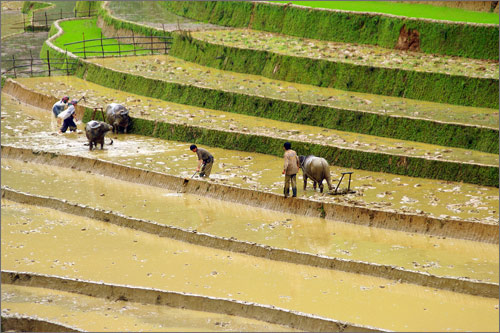Scattered along the coastline are many resorts offering comfortable and luxury accommodations and other services for tourists to relax during their holidays. And off course, in return for the comfort, vacationers have to pay more money.
However, there is a cheaper, but no less interesting, way to make the trip to Mui Ne for backpackers or travelers on a limited budget.
Bus is the cheapest means of transportation to get there. From HCMC, travelers can buy bus tickets at open-tour operators, such as Sinh Café and Phuong Trang among others. A number of tour providers offering daily tours to Mui Ne have offices located in the heart of the city, on De Tham Street and Pham Ngu Lao Street, with buses usually leaving in the morning.
With tickets costing from VND60,000 to VND65,000 (US$3.8) each, travelers will make their journey in a 45-seat, air conditioned bus. In addition, the ticket includes a bottle of pure water, a paper tissue and a bag of coconut.

Travelers get on a bus at Mui Ne Resort to return to HCMC
For reasons of safety, the driver will often keep the bus running slowly enough for passengers to enjoy looking out of the windows at the landscape and scenes of the daily activities of people living along the national road!
After four hours and some 220 kilometers, travelers will feel the sea winds in the air as they approach the ‘kingdom of resorts’ in the Mui Ne region.
The artery street of Nguyen Dinh Chieu divides the resort town into two separated worlds. One side is dotted with many luxury and comfortable resorts along the pristine beaches, meanwhile on the other side is the world of restaurants, boutique shops, entertainment services and guest houses or inns.
Depending on the weight of their pockets vacationers can choose a luxury service or a comfortable accommodation. For those in search of less expensive options, inns or guest houses are the best choice for their stay during their holidays.
Prices are changed subject to the travel season and days of the week. However, a good bargain will provide travelers an air-conditioned room for two with prices ranging from VND100,000 to VND150,000, or from VND60,000 to VND80,000 for a room with fans.
Vacationers will also find a wide range of pricing for dining, according to their taste. Restaurants scattered along the street serve many different kinds of food, including Vietnamese, Korean, Indian and French among others. However, a seafood barbecue is what a traveler should try, with prices starting from VND35,000 per dish.
To explore the region, one can hire a motorbike or a bicycle priced at VND70,000 and VND15,000 respectively for 24 hours. There are also buses running from Phan Thiet City to Mui Ne every 30 minutes with tickets ranging from VND3,000 to VND8,000 each.
For swimming, one can ask any local for a path leading to the beach, and of course, one can swim freely anywhere once they get to the water.














.jpg)















